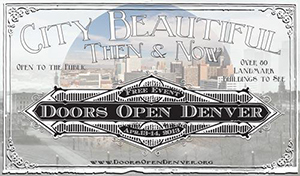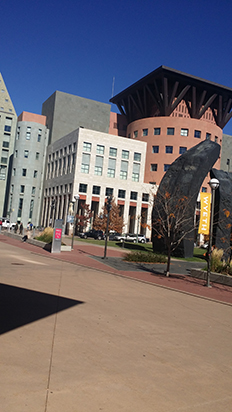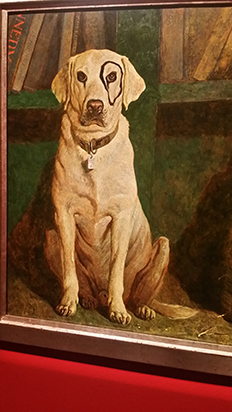LETTERS FROM THE GLOBAL PROVINCE
Denver Never Blossomed, Global Province Letter, 2 December 2015
Memories of Villa Italia
After "Memorie di Villa Italia" (1961), by Vance Kirkland
Sure, I remember Villa Italia.
It was a beautiful shopping experience.
800,000 square feet of consumabilia.
Yeah, I remember the Villa Italia.
Spencer's Gift with psychedelia,
Orange Julius and the fashion trends.
Sure, I remember Villa Italia.
It was a beautiful shopping experience.The artist paints a different villa,
one that bleeds with lights and blooms,
with hieroglyphics and vanilla.
The artist dreams a different villa:
a home that could produce
Godzilla from any of its clouded rooms.
The artist paints a different villa,
one that bleeds with lights and blooms,Perhaps the poet got it wrong.
One doubts the artist did.
To cast an oil paint in song...
perhaps the poet got it wrong.
He's not been at this very long...
in fact he's practically a kid.
Perhaps the poet got it wrong.
One doubts the artist did.-- J Diego Frey January, 2015

Not Quite a City. To go to Denver is not to be sure you are there. Thirty years ago we'd go there to lecture and such. The organizers would put us up near the old Stapleton Airport and they'd find some cavernous venue a few miles from its runways where we would spout off. For entertainment we'd tour the many fine old used bookstores that then defined Denver for us or visit an old friend or two around town. If we went to see somebody in an office tower downtown, we would merely stare out the windows at the beautiful mountains in the distance and wish we were there on the hills (just like Denver's fulltime residents). One could best do about the same thing now, except the newish unwieldy Denver International Airport is harder to navigate and there are many fewer bookstores, Denver's old quiet culture having dissolved.
Denver's sprawl has devoured much of its recent past such as Stapleton. It, as well as the Villa Italia shopping center, celebrated in the poem above, have gone under the hammer of the real estate developer. Memories are easily swallowed.
If you do downtown today, you are never sure you have arrived anywhere, and you find yourself still searching for the big enchilada. For the almost city is really a potpourri of strung on neighborhoods, full of malls, and the visitor never is quite sure he's discovered the core. The city started as Auraria (a nicer name) in 1858, its moniker borrowed from a Georgia gold mining town. Soon enough, sadly, it was renamed Denver, after the territorial governor, by land speculator William Larimer Jr. All too quickly it went from an enchanted place connoting gold and great dreams to a struggling locale commemorating smalltime minor league barons. Ever since, greatness has eluded the town beneath the Rockies.
Paradoxically, of course, there's an invisible Denver, as we shall make clear, that is very enticing, such that young people in many parts of the nation, having hit a dead end in other states, have flocked to the town for its start-up jobs and very friendly spirit. Maybe we should call it the nation's invisible city. It is the hidden, elusive Denver that one wants to discover.

Hidden off in a Neighborhood. So it is best we think to treat Denver as a series of little villages where one can discover some gems if you look real hard. But always outside the malls. In Cherry Creek you will find a linen store that has some truly outstanding wares. Fruition Restaurant, as good as it gets in Denver, is located in a modest enough house on East 6th Avenue, in a pleasant but far from glitzy neighborhood. The key is that chef owner Seidel sources very good ingredients and cooks them simply enough so that the offerings do not get overwhelmed by frippery. His staff is quite mannerly and very anxious to please, and generally one does not feel rushed. The Times, which praises this eatery, altogether misses the fact that its secret is simplicity and lack of pretentiousness. Denver today is at its best when it does not try to overdo it.
Disappointments. Some loudly, some softly acknowledge that the visible city is missing something vital. The onetime governor Richard Lamm is very blunt about its failings:
I've had some major disappointments. The quality of life in Denver is worse than when I took over, and I'm embarrassed about that. But I still put in 40 hours a week running Colorado.Sprawl is the American ideal way to develop. I believe that what we're developing in Denver is in no appreciable way different than what we're doing in Los Angeles -- did in Los Angeles and are still doing. But I think we have developed the Los Angeles model of city-building, and I think it is unfortunate.
Even Denver's cheerleaders have to own up occasionally that it leaves much to be desired. Jenny Shank, novelist and rhapsodic Denver fan, admits the literary scene may lack a thing or two:
I set my first novel and most of the short stories I've written so far in my hometown. But it's true, there isn't much literary fiction set in Denver. Even though the city is full of writers, many of them choose to set their work elsewhere, perhaps because many residents didn't grow up here and writers often set their work in the places that they're from. And Denver has no book festival. We hang our heads in shame before you Omaha; Missoula, Montana; Tucson, Arizona; and Salt Lake -- all home to rocking public literary festivals. Colorado discontinued its grants to writers during a budget crisis over a decade ago, and never brought them back. Several years ago, the National Endowment for the Arts threatened to cut off all grants to Colorado residents due to a lack of arts infrastructure in the state to administer them. Luckily, this never came to pass.

But We Can Hope. It's easy enough to say that Denver is a city that is never going to happen. But that is to neglect its past and to ignore its present. Robert Walter Speer, mayor of Denver from 1904 to 1912, was a passionate adherent of the City Beautiful Movement and did a host of things to transform the city from a spattered Western town into a planned community of trees, and paved streets, and parks. Under him Denver took a leap forward. Occasionally the city looks like it will find itself and understand its place in the sun. Maybe mile-high Denver, a city in the sky, will take a century or two, rather than decades, to capture its destiny. It's not to be rushed.
Today the visitor should take in the Denver Art Museum and environs, not to be inspired by its spotty art collection, but to take in a nice architectural assemblage, to sit in a pleasant museum restaurant, and to see visiting shows tastefully displayed in comfortable spaces. Daniel Libeskind's building for the Denver Art Museum and his work in the surrounding area have started a cultural district which is virtually the only architectural complex of note we have seen in the whole metropolitan area. But it is first class and could very well become the beautiful heart of the city. In "Mile-High," we learn:
His new building for the Denver Art Museum, which opens this fall, is his first American work to be completed. It's already so popular in Denver that Libeskind was invited to construct a pair of condominium buildings and a hotel next door, and to design a neighborhood plan for a "cultural district" surrounding the museum. Marketed as the creations of "world renowned architect Daniel Libeskind" -- whose face is all over the brochures -- the apartments are among the highest-priced condos in town. Such success is a reminder of the fact that second-tier American cities have often proved more willing to take architectural risks than supposedly sophisticated cities like New York. … This is a bold building, and it is neither an inaccessible theoretical work nor a brazen piece of entertainment, but somewhere in between.

The museum houses a first class restaurant called Palettes and an ample gallery space for visiting temporary shows such as the beautiful Wyeth exhibit now housed there. Museums are generally patchwork uncomfortable spaces (save for the wonderful edifices orchestrated by Louis Kahn in Dallas and New Haven), but Denver has outdone itself in making a building inviting on the inside and uplifting on the out.
More Than Meets the Eye. . That Denver has never quite become a city and does not look or seem like much distracts us from the big story. For young people across America it is a place to go. Because there are jobs, for instance. In September, the unemployment rate was 3.2%, well ahead of the national average. As you move about, you bump into lots of young people, a surfeit of fun often college-educated twenty and thirty somethings who even serve as bellhops and waiters at the better hotels. The customers at better restaurants are not at death's door. Oft as not a visitor to the city will pick up a conversation easily with the fellow next to him, the town nicely infected with a contagious friendliness not found in other hard-bitten, more sophisticated American metropolises. The upside of a Denver that is not urbane is this neighborliness that masks other shortcomings.
P.S. Denver locals make a great deal out of the fact that it was a stop along the way for some renowned Beat writers decades ago, who stopped for a while before moving on. This includes Jack Kerouac and his sidekick Neal Cassady who today is remembered via a blog called Neal's Denver. This is charming. And it fits in with a Denver where the culture is often hidden underground. Moving is a snippet from Allen Ginsberg's Howl about those "who journeyed to Denver, who died in Denver, who came back to Denver & waited in vain, who watched over Denver & brooded and loned in Denver and finally went away to find out the Time, & now Denver is lonesome for her heroes." Denver must pine for its heroes.
P.P.S. We're not sure what it tells us but Denver is proud of its beer consumption and output. The state, according to some, has more breweries than any other state, and is said to have 6-7 craft breweries per capita. For sure, it ranks number one in gross beer production. Clearly beer is one of the things you do in Denver.
P.P.P.S. Marijuana is sure to join beer as another mainstay of the Colorado and Denver economy. At breakfast one morning an out of towner from Los Angeles picked up a conversation with us that ran on and on for two hours, mainly filled with tales of his personal exploits. He was an unconventional entrepreneur. But he also essayed at length about his current business enthusiasm. He has bought many deserted warehouses at the edge of Denver, which he has turned into greenhouses for his vast and expanding crop of marijuana. Clearly the Mile-High City is on its way to becoming the Nine-Mile-High City.
P.P.P.P.S. Those interested in the wonderful but rather extravagant new flood of museums should read "The Explosion of Museum Architecture" by Richard Francis.
P.P.P.P.P.S. . Too late we have learned that the most singular phenomenon in Denver is its corpse flower. It smells awful, takes forever to bloom the first time (13 years for the Denver plant), and is large to boot. Surely the truly curious will time their visits to Denver to coincide with its infrequent blossoming at the Botanic Gardens. Chicago also has one of these imports from Indonesia. Just like the corpse flower, Denver itself can blossom: it just takes a while.
Home - About This Site - Contact Us
Copyright 2015 GlobalProvince.com